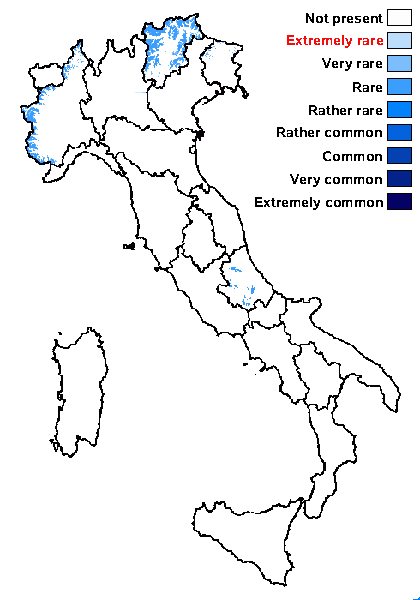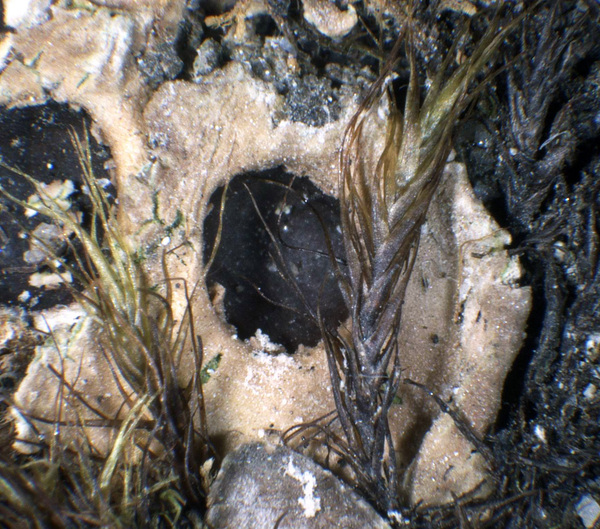Solorina bispora subsp. macrospora (Harm.) Burgaz & I. Martínez
in Martínez & Burgaz, Ann. Bot. Fenn. 35, 2: 140, 1998.. Basionym: Solorina macrospora Harm. - Lich. de France, 4: 661, 1910 (1909).
Synonyms: Solorina bispora var. macrospora (Harm.) H. Olivier
Distribution: N - Frl, TAA (Nascimbene & al. 2006), Piem (Matteucci & al. 2015b). C - Abr (Gheza & al. 2021, Di Nuzzo & al. 2021, Vallese & al. 2022)
Description: Thallus small-foliose to subsquamulose, heteromerous, dorsiventral, 5-10 mm wide. Lobes rounded or irregular, flattened, smooth, poorly developed and sometimes reduced to a collar around the apothecia, the upper surface pale greyish-green, sometimes tinged brown, often white-pruinose, bright green when wet, the lower surface white, indistinctly veined, tomentose, with scattered, pale rhizines. Upper cortex paraplectenchymatous, lower cortex absent; medulla white, rarely hosting internal cephalodia. Apothecia frequent, usually 1 per lobe, semi-immersed, 2-5 mm across, with a brown to brown-black, concave disc, without a thalline margin. Proper exciple poorly developed; epithecium brownish; hymenium and hypothecium colourless; paraphyses coherent, not anastomosing, simple, the apical cells hardly swollen. Asci 2-spored, clavate, fissitunicate, the apex of the endoascus with a K/I+ blue ring-shaped structure, Peltigera-type, Ascospores 1-septate, constricted at septum, dark brown, ellipsoid to broadly fusiform, 95-145 x 45-60 μm, with a thick, reticulately ornamented wall. Photobiont chlorococcoid (Coccomyxa), with Nostoc in the internal cephalodia. Spot tests: upper cortex and medulla K-, C-, KC-, P-, UV-. Chemistry: without lichen substances.Note: distinguished by the larger spores, this subspecies is probably more widespread in the Alps than the few records would suggest. See also note on subsp. bispora.
Growth form: Foliose, broad lobed
Substrata: soil, terricolous mosses, and plant debris
Photobiont: green algae other than Trentepohlia
Reproductive strategy: mainly sexual
Commonnes-rarity: (info)
Alpine belt: rare
Subalpine belt: very rare
Oromediterranean belt: absent
Montane belt: absent
Submediterranean belt: absent
Padanian area: absent
Humid submediterranean belt: absent
Humid mediterranean belt: absent
Dry mediterranean belt: absent

Predictive model
Herbarium samples
Growth form: Foliose, broad lobed
Substrata: soil, terricolous mosses, and plant debris
Photobiont: green algae other than Trentepohlia
Reproductive strategy: mainly sexual
Commonnes-rarity: (info)
Alpine belt: rare
Subalpine belt: very rare
Oromediterranean belt: absent
Montane belt: absent
Submediterranean belt: absent
Padanian area: absent
Humid submediterranean belt: absent
Humid mediterranean belt: absent
Dry mediterranean belt: absent

Predictive model
| Herbarium samples |
 INDEX FUNGORUM
INDEX FUNGORUM
 GBIF
GBIF
 DOLICHENS
DOLICHENS




